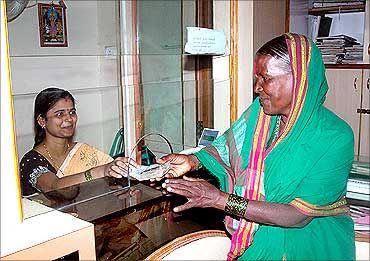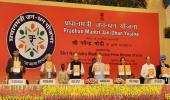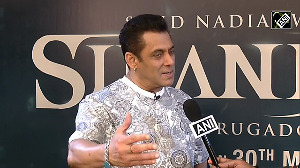The Jan Dhan scheme restricts the scope of life insurance cover to bring down burden on the exchequer.
 The government has started applying exclusion principles to its inclusion scheme, the Pradhan Mantri Jan Dhan Yojana (PMJDY).
The government has started applying exclusion principles to its inclusion scheme, the Pradhan Mantri Jan Dhan Yojana (PMJDY).
The life cover of Rs 30,000 announced by Prime Minister Narendra Modi for all those opening a bank account under the scheme will now exclude many.
The finance ministry has put several riders for defining one's eligibility for a life insurance policy under PMJDY.
In the guidelines issued to banks last week, the ministry said the insurance would be provided only to one person in a family for accounts opened between August 15, 2014, and January 26, 2015.
Those filing income tax returns, serving and retired central and state government employees, employees of central and state public sector entities, and people already covered under the Aam Aadmi Bima Yojna have been excluded. The families of the individuals in all these categories will also be ineligible for it.
"The scheme aims to provide security to those families who cannot afford life insurance, namely the urban poor and the rural poor, who are not covered under any social security scheme," the finance ministry said, in the guidelines reviewed by Business Standard.
The life cover will initially be only for five years and provided to the head of the family or an earning member in the age group of 15-59 years.
The person will be excluded from the life insurance scheme after turning 60. So, someone who opted for it at the age of 59 will be covered only for one year.
The account holder should also have an active RuPay debit card (used at least once in 45 days) and a biometric card linked to the account to get the benefit of the life cover.
"Those who already have a life cover from some other scheme will have to choose between the existing one and the one under PMJDY," said a finance ministry official, asking not to be named.
Since accident insurance of Rs 1 lakh, along with a RuPay debit card, was available even before the launch of the scheme and would be effective only up to March 31, 2015 (its extension will be reviewed later), life insurance and credit facility were the two main attractions of PMJDY. Absence of a life cover might make the scheme unattractive to many and hurt the financial inclusion drive.
Launching the scheme on August 28, the prime minister had set a target of taking banking to 75 million households by January 26, 2015.
Although 78 million accounts have already been opened, 20 per cent of households are still unbanked. Many people who already had an account opened another one. Only 47 million of these account holders have a RuPay card and 59 million accounts have zero balance.
"Now, only the families which are truly eligible for the scheme will get the benefit," said a member of the State Level Bankers Committee, looking at the rollout of the scheme in a western state.
Restricting the scope of the scheme will reduce the burden on the exchequer. Life Insurance Corporation of India will create a fund for life coverage with an initial corpus of Rs 100 crore from the Social Security Fund of the Centre.
It will be replenished by the government from time to time within the stipulated premium amount to meet the outgo and administrative expenses.
 Earlier, the government had said the accidental insurance cover and life cover will be available to all account holders. Problems have started surfacing on the accidental insurance front, too.
Earlier, the government had said the accidental insurance cover and life cover will be available to all account holders. Problems have started surfacing on the accidental insurance front, too.
Although the insurance programme had come into effect from April 1, 2014, claims have shot up after the launch of PMJDY and the issue has been raised with the finance ministry as the insurers did not anticipate such high claims.
"People who got the RuPay card as part of PMJDY have started filing accident insurance claims. We are awaiting more clarity from the finance ministry," said the person mentioned above.
The RuPay card is being given free of cost to the customer and the National Payments Corporation of India pays the premium of Rs 0.47 per card to HDFC Ergo. It can be given to any account holder and every member of a family.
A person who is already having a bank account with any bank just needs to get issued a RuPay card in his existing account to get the benefit of insurance.












 © 2025
© 2025